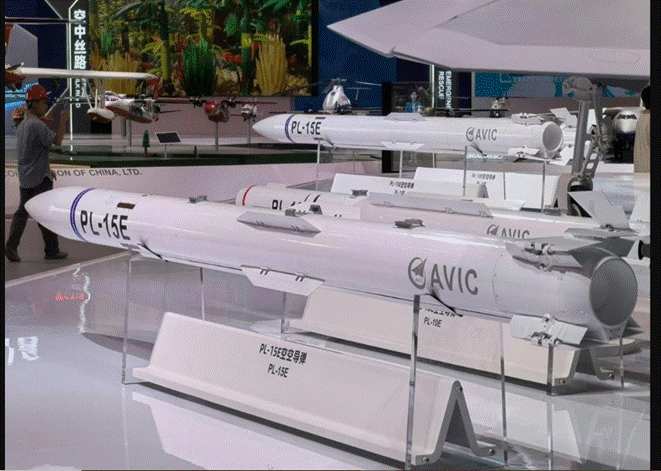The People’s Republic of China is showcasing its growing technological power after establishing itself as an economic giant. Recent Indo-Pakistani tensions have highlighted China’s rising military influence, as Pakistan, using older-generation Chinese jets, reportedly downed some of the most advanced Western fighter aircraft, including France’s Rafale, during air combat.
Most importantly, China has not yet supplied Pakistan with its most advanced hardware. The Pakistani Air Force primarily operated Chinese-made J-10C fighters and JF-17 jets, aircraft that are considered a generation behind the stealth standards of U.S. platforms like the F-22 or F-35. Despite this, these jets were allegedly able to shoot down five Indian fighter aircraft.
The real game-changer wasn’t just the aircraft themselves, it was the technology behind them. For example, the J-10C has a radar system boasting a detection range of over 240 km, almost 50% greater than that of India’s Rafale. When paired with a robust airborne warning and control system like the Chinese ZDK-03 (even an older model), this creates what is known as a “detection overmatch.”
In practical terms, this means enemy jets can be detected long before they can lock on with weapons and sometimes even before the pilots are aware they’ve been targeted.
Adding to this advantage is the PL-15 air-to-air missile, one of the longest-range missiles in service today, capable of striking targets at ranges exceeding 200 km. Together, these capabilities, radar superiority, long-range precision strikes, AI-powered targeting, and tight systems integration give Chinese-designed jets a formidable edge.
Chinese-designed jets combine brute force with advanced systems integration, radar superiority, long-range precision, and AI-powered targeting capabilities.
Here are a few Chinese-designed military systems that are now dominating the global military landscape:
- JF-17 Fighter Jet
Fully operational since 2024, the JF-17 Block III is equipped with the KLJ-7A active electronically scanned array (AESA) radar, designed to track multiple targets simultaneously and resist electronic jamming attempts. However, the Pakistani fleet remains heterogeneous: out of roughly 150 aircraft in service, only about 45 to 50 units are Block III variants fitted with this advanced radar. The earlier JF-17 Blocks I and II, equipped with mechanical KLJ-7 radars with limited performance, are not capable of fully exploiting PL-15E’s potential. To date, there is no evidence that these older aircraft have been upgraded with AESA radar systems.

- J-50 Fighter
China’s ambitious sixth-generation J-50 fighter, crafted meticulously by Shenyang Aircraft Corporation (SAC), reportedly incorporates advanced artificial intelligence (AI) into its flight management system, capable of autonomously evaluating complex combat scenarios, identifying threats, and executing tactical decisions, thus dramatically reducing pilot workload and enhancing strategic operational capabilities.
The Electro-Optical Targeting System (EOTS) is an advanced, high-performance sensor array employing electro-optical and infrared capabilities to detect, track, and precisely engage aerial and ground targets across significant ranges, regardless of weather conditions or visibility, day or night.
Integrated within the EOTS are high-resolution imaging sensors, Forward-Looking Infrared (FLIR) cameras, and precision laser designators that effectively guide an arsenal of precision-guided munitions, such as advanced air-to-ground missiles and smart bombs.
Additionally, the incorporation of Thrust Vector Control (TVC) provides the J-50 unmatched agility, enabling its engine nozzles to pivot dynamically mid-flight, significantly enhancing combat maneuverability, particularly during close-range dogfights.

- PL-15E Missiles
Developed by the China Airborne Missile Academy (CAMA) under the Aviation Industry Corporation of China (AVIC), the PL-15 is considered one of the world’s most formidable BVR air-to-air missiles, rivaling the American AIM-120D AMRAAM and the European MBDA METEOR in both range and electronic counter-countermeasures capability.
The PL-15 in domestic form is operationally integrated with advanced Chinese fighters such as the stealthy fifth-generation J-20 “Mighty Dragon,” although recent reports indicate that the J-20 is beginning to field an even more powerful air-to-air missile known as the PL-17, believed to have an engagement range of up to 400 kilometers.

- J-10 C
The J-10C or “Chengdu J-10” is a medium-weight, single-engine, multirole combat aircraft using a delta wing and canard design. It is produced by the Chengdu Aircraft Corporation (CAC) for the People’s Liberation Army Air Force (PLAAF), Pakistan Air Force (PAF) and People’s Liberation Army Naval Air Force (PLANAF).

- CHENGDU J-20 “MIGHTY DRAGON”
The J-20 “Mighty Dragon” is a single-seat, twinjet, all-weather, stealth, fifth-generation fighter developed by China’s Chengdu Aerospace Corporation for the People’s Liberation Army Air Force (PLAAF). Designed as an air superiority fighter with precision strike capability, it undertook its maiden flight in January 2011, entered service in March 2017 and commenced its combat training phase in September 2017. The first J-20 combat unit was formed in February 2018. The J-20 is the world’s fourth fifth-generation stealth fighter after the American F-22, F-35, and Russian Su-57. It will effectively supersede Su-27SK, Su-30MKK and Su-30MK2 in the PLAAF inventory. Chinese state media reported in October 2017 that aircraft is ready for mass production. In January 2019, a twin-seat variant of the J-20 was rumoured to be in development for use in tactical bombing, electronic warfare and carrier strike roles.





